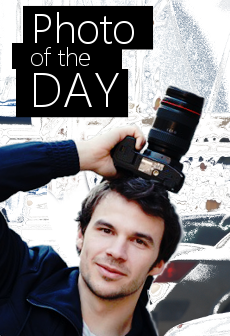An Interview with Composer Gheorghi Arnaoudov by Jasmina Tacheva
Translated by Jasmina Tacheva

Photo: Gheorghi Arnaoudov – Photo Alexander Nishkov
People involved in the performing arts, contemporary theater, ballet, etc., often turn to your music. What do you think – what property of it evokes this?
You start with the most difficult – the analysis of the properties. Probably, at least that’s the way I see it, they accept me as a composer in the classical sense. I deal more with the design of sounds, with a kind of aural architecture.
Basically, what I write is related to the idea of sound adopted as a key mediating layer and silence as the main medium of its genesis – just like what light is to the color for the painter or the fabric of a piece of marble for the sculptor.

Photo: Gheorghi Arnaoudov – Photo Alexander Nishkov
It’s about building the contours of the sound, about its perception, about its relief and tangibility, its vibrations and linkage to the other, the next sound, and their arrangement in an endless matrix of rhetorically self-developing lines, the organization of their inherent logic and hence the energies these lines evoke to create a particular subtle level of perception out of which the musical image emerges and is outlined.
Thus presented, things already become difficult, and this is something that I discuss and rationalize quite often lately. My posing this problem is no coincidence, since such a starting point is typical for a new awareness of the philosophy of music and its existence, and this is already an infinitely metaphysical problem.
Such a philosophy actually fits with the empty stage space as well – seen as the coordinate system, provoking all possible and so complicated games in terms of its occupation with objects, images and movements, meanings, ideas.
 “Blachernae. The Veil of Our Lady” (2012) is selected for Mayia Pramatarova’s play “Don’t Take the Bridge”. How did this happen? When did you first meet Mayia and have you two worked together before?
“Blachernae. The Veil of Our Lady” (2012) is selected for Mayia Pramatarova’s play “Don’t Take the Bridge”. How did this happen? When did you first meet Mayia and have you two worked together before?
Mayia was introduced to me, if I am not mistaken, many years ago by the actor Izko Finzi, with his magnificent way of bringing together and uniting people from different backgrounds and communities… Despite living in different parts of the world, this is one of my closest friends. “Don’t Take the Bridge” is already the third joint project since “Kill that woman!” and “The Revolver” – and I am very glad she is starting out so well.

Photo: Choreography: Violeta Vitanova and Stanislav Genadiev
As for the choice of “Blachernae” – about a week after our premiere in “Bulgaria” Hall on January 12, I sent her the record. I was in great need of an independent opinion. A little later she emailed me the following:
“A purifyingly mystical sound – it carries you into an alabaster temple in which the light is filtered through the gem. This is the light of parallel lives and worlds arising in fore-timely zones. There is a certain deposition in the sound which is clean, not with a primordial simplicity, but rather with an acquired one that treasures the knowledge of complexity in its cell. Oh, did it come out too fuzzy … “

Photo: Gheorghi Arnaoudov with the British composer Michael Finnissy and The composer Gheorghi Tutev
How do you think the music corresponds to the script?
This is the question of the correlation between the expression of the various arts – a difficult enough problem amidst an infinitely unclear category, despite the numerous attempts for analysis.
At a formal level, this can be seen as the discovery of possible con-formity between the various levels of texts – notional, visual, musical, in the balance between the image and the background, between the specified ideas and the comprehensively constructed stage order.
At a deeper level, these are the complex networks of the relationships that make up the contrapuntal lines of the stage volumes into an elaborate psychological and emotional context. Here, Robert Wilson’s “Shakespeare Sonnets” and the “Berlin Ensemble” in 2009 come to mind.

Photo: Gheorghi Arnaoudov – Photo Alexander Nishkov
What is your impression of the play? Why did you think “Blachernae” would be suitable for it and vice versa?
I only have the script of the play at my disposal. The choice of music and its emplacement in the context belongs therefore to Mayia and Stavri Karamfilov. I hope – and I was told – that the result was very powerful. I realized however, that the music has been placed exactly at the moment where I imagined it to be – without my intervention – not just because of the 7580-kilometer distance – with modern technology this could have happened easily electronically, but personally, I myself, avoid such an approach.
I think that thus, the autonomy of the individual elements is maintained and an opportunity for a freer contact with the idea of interdisciplinarity is created – understood as a complex mutual generation of expressions, images and text, and not as a mechanical juxtaposition of components that provide background and routinely, cliched and seamless construction of familiar scene hierarchies and relationships.

Photo: Choreography: Violeta Vitanova and Stanislav Genadiev (Bulgaria)
“Blachernae” is the place where Emperor Constantine died at the hands of foreign invaders. This is a symbol of the decline of a great culture and the rise of another culture. The play “Don’t Take the Bridge” too, at a particular level, is about the counterforce of two cultures and the interchange of one with the other.
Your music helps the play emerge on the archetypal level of generalizations, because the play is about the same, but also on the level of the fate of specific individuals and their dramatic lives, and your music becomes a metaphor that sends the performance to whole new levels and the characters leave Manhattan, detach from their contemporary problems and passions and grow to archetypal figures.
I share this opinion of the author of the play, Mayia Pramatarova, but how do you yourself feel enriched by your theater work? Furthermore, can you imagine writing music for a specific theatrical work or even for a scenographic decision – the sort of experience that directors and composers such as Robert Wilson and Philip Glass have?
Such kind of cooperation has always been extremely fertile. And this applies to the possibility of exchanging ideas and joint creative work, and also to the mode of organization of team thought, the push aside from their own chaos and the entry into the mutually constructing, far more fruitful, interdisciplinary manner which models stage ideas and energies. And this is already a step towards restoring some order in the so threatening moral and cultural chaos of today’s world.
So, the emerging archetypal models in question, the return to the ritual and the search for spiritual support are a possible solution … Actually, the fragmented thinking in contemporary culture and life, the granulation, the emphasis and fixation on problems and the flight from ideas, and especially the materialization of the the Spirit can be placed at the heart of structural disorder at all levels.

Photo: Choreography: Violeta Vitanova and Stanislav Genadiev (Bulgaria)
As for my work on stage – although it is not my only occupation – I would define it as one of the cornerstones of my thinking. I can define as a great chance the opportunity, however scattered in terms of chronology, to work with different producers, directors, choreographers – artists who have stimulated my thinking and helped me very much in laying the foundation of my moral and cultural norms.
In this plan I place my current work with the Mayia – in this case especially interesting and fundamental, as far as the actual co-creation of the stage existence, of new and significant dramatic texts that build ideas and order, goes.

Photo: Gheorghi Arnaoudov with the choreographer Mila Iskrenova
What would you say to the people who will read our conversation to convince them that they should support our project “Don’t Take the Bridge” in order to enable its staging on one of the New York scenes?
I live too far away, I have never been to New York – I know this context mainly from the screen, and here I would mention Woody Allen who is my window to America. Personally, I avoid action movies – to me, they are a kind of pop-folk in cinema – and I don’t have a TV …
But I would return once again to the recovery of the cognitive, moral and cultural order – the ubiquitous disarray and chaos can be related to the way of thinking, the line of behavior and the means of expression.
Thus seen, disarray and chaos – in Greek “chaos” means an abyss – are prerequisites for ignorance, hatred, and hence for destruction. So the presentation of such a script, and of any type of organizing, cultural-order-bearing and valuable works is something of sufficient importance. These are vital elements of the construction of a peaceful and orderly future.

Photo: Space crossing 2 – Choreography: Mila Iskrenova
Mr. Arnaudov, you are referred to as a composer of symphonic, chamber and theater music; where are the boundaries between these types of music – can’t symphonic music also be theater music; theater music – chamber music and so on? In short, can we talk about boundaries in the arts today at all?
Perhaps nowadays it is very difficult to draw the line between them. Especially after the invention of cinema. First, this refers to the representation itself, to the visible side of things. Interactions are already in place; the interdisciplinary thinking, the combination of layers and mediums of expression are something natural and even predictable. But the mix of contexts led to major readjustments in the life of the arts.
Symphonic and chamber music are cultural and social practices that belong to the past or, if they still do exist, they may be reduced to the exotic. What gets presented in the public space as a “concert” – and in Bulgaria this applies to pop-folk, rock and pop music – can be seen more as a mass event of a sports or commercial type.

Photo: Space crossing 2 – Choreography: Mila Iskrenova
Then come the semantic interactions between the arts, the new approach to the understanding of the major species and genera and the types of their expression. Ever more often this leads to the invention of some new methods for pushing away from the collapse of the disorder of the musical meanings that has been pouring on us, from the profanation of musical expression and its transformation into a commercial product and feedstock for fast consumption.
The period from the late 19th century up till now is an era of great musical transformations; new worlds of sound, new technologies of sound and new musical tools were discovered. The giant noise of machines, the mechanical city roar produced by humans and the new procedures of thinking were invented. But despite all this, in general, the ethos and expression have remained the same; the above metaphysical primordial elements – sound and silence – as well as their relations, have remained the same.

Photo: Space crossing 2 – Choreography: Mila Iskrenova
How should music be taught, apart from the technical skills? How is composition taught? Can one learn to be a composer? And what was your personal path of a boy dealing with music to the person who writes music performed by international orchestras, recorded on discs, etc.?
It can be seen as a complex form of suggestion. The techniques for writing and training are aspects that are a prerequisite. Next comes the teaching of creative writing, the creation of music – something tantamount to the creation a very elaborate field of conditions, energies, new ideas and suggestions.
I’m saying all this on condition that the creation of a melody, its harmony, the setting of its rhythm and so on – procedures in the creation of a song we’ve known for centuries, in and of itself, is not yet an act tantamount to the creation of a serious music text. This usually happens very slowly and the very awareness of the condition of the creative process, its realization, is is far more valuable and precious than the fast result.

Photo: Gheorghi Arnaoudov with Vassil Kazandjiev and Yordan Dafov
From there, the way leading from the spontaneous idea and the sound presentation, the transition from the symbol and its rhetorical transformations through the realization of the sound energy and the reaching of that meta-consciousness, to that transcendental sound language – all this is an extremely long way which sometimes may never end …
As for my personal path – it was quite steep at times, I continue walking and avoid looking back – this is a dangerous action leading to vanity and pride. And those are well known errors.

Photo: Carl Maria von Weber Prize Award Ceremony in Dresden
You have a rich teaching experience at the New Bulgarian University and the National Music School “Lubomir Pipkov.” What are your personal observations regarding the young generation – at a time when the whole world is more or less groaning under the pressure of the financial and economic crisis, is a spiritual crisis in music circles as well, or are you inclined to an optimistic outlook for the future?
The financial crisis is a global problem and it is derived over the years from developing waves of rise and fall varying in strength and from economic and spiritual crises. A positive culture-focused strategy – of the individual artist or the group – should use the benefits of crises as difficult as this may sometimes be.
I’m saying this as a person who creates, who regularly finds himself in stages of crisis and enthusiasm I gradually try to channel into thinking aimed at overcoming the stages of the disorder to which both states lead. Creation is probably a well-organized crafts work.

Photo: Carl Maria von Weber Prize Award Ceremony in Dresden
By watching the students and their later development as students at the New Bulgarian University, I would say that we have before us a generation with great potential and creative energy that ought to be very well organized and developed; a generation with immense information and talent. The responsibility for their development as active and enterprising creative persons that fit into the real cultural context and work for its development, is enormous.
In fact, in the university – and this is already an important center for the training in music and art in Bulgaria – students have the opportunity to work with teams of elite musicians such as Raina Kabaivanska, Milcho Leviev, Milena Mollova, Ludmil Angelov, Stefan Dragostinov Mario Hossen, Simo Lazarov, Angel Zaberski and many others; to seek and explore – and I’m not only talking about composition – all this is already a great privilege and I think we have many valuable students.
Recently, you completed a PhD program in musicology and musical art. What are the observations and discoveries you have made that impressed you most?
If I try to synthesize that idea, it would be the realization of the functioning of language and style of music in the context of the postmodern era. Currently, I am preparing the paper for publication with the working title “Music of the postmodern era – language and style.” The paper is not a discovery, but rather an attempt to systemize. A cursory attempt to introduce some order in our understanding of music with all the various expressions of this art today.
In one interview you say that two important cultural aspects were born in the Balkans – mythology (Greek – “to talk a lot”) and mysticism (“silence”). In your opinion, which of the two does art tend more towards – silence or talkativeness?
The dichotomy mythology / mystery can be understood precisely in terms of the philosophy of sound I previously discssed. Mythology is a term derived from μῦθος – and that means a word, speech, whereas mystique comes from μύστης – a derivative of μύω – “to close” (in the ancient practice of initiation – the eyes or the mouth), ” to keep silent”. To define these two categories derived from sound and silence, is something great.

Photo: Half cup sesame seeds – Choreography: Idan Cohen (Izrael)
Art, as an expression of the creative philosophy of the individual author, can branch in one of the two “sides” or a combination, built by means of a much higher style of thinking. Authors such as Boulez, Cage and Berio, or, more recently, like Adams or Golihov are wonderful examples. The European culture we know and live, think and create in, is built precisely in the synthesis between the ancient thought and the Christian spirit and I myself am often seeking support in this order that is lost to us.
You describe the exceptional spiritual experience at the face of the Virgin Mary of Blachernae. How important is faith in order to come to this ecstasy? Would an observer without the necessary knowledge and especially – faith – be able to sense the singularity of this icon that is much more than just a work of art?
The area of the church “The Holy Mother – Blachernae” is quite modest and ascetic, populated with light and sound. To me, the contact with this condensed spiritual matter was striking. Actually, I did not know where I was taken. It was like initiation. Much later did I realize that this is the first Odigitria – The Holy Mother that shows the Way.
It is said to have been painted by Luke the Evangelist’s own hand or that it has been made in the VII century. But the portrayal of Mary is made using a rare type of a painting technique – encaustic. According to the Christian tradition, the pigments and the wax for this icon have been mixed with the dust of the dead Christian martyrs … This is amazing …

Photo: Gheorghi Arnaoudov with the conductor Plamen Djourov and the pianist Ventsislav Yankov
In this sense, you point out that unlike the typical tourist spots of Constantinople, in front of the Virgin Vlahernskata you have felt that you don’t feel like “polluting” it by taking a picture with your camera. Do you think that high art should also maintain a certain level of sanctity and integrity?
Necessarily. This is a prerequisite for its existence. Otherwise it becomes merchandize. And this is already a different category of work and quite another matter. As for the entry into the church, I really felt there was room for contamination by modern technologies.
The mechanical memorization of experiences through different devices is already possible, but it has become too dangerous and too much with regards to the normal functioning of human emotions and spirituality. Here, I can immediately think of music and the opposing views regarding Glenn Gould and his life in the studio and Celibidache’s refusal to make studio recordings …
But just imagine this ascetic space with the icon – the light, the spring with water dripping for centuries, the monk who sings in front of the fountain… all this holy space that instantly creates powerful melodies and layers of colors and sounds, merging with the rhythm of the still reverberating drops of the tears shed by Mary …

Photo: Gheorghi Arnaoudov – Photo Alexander Nishkov
If you were asked to describe the feeling that struck you while contemplating the image of the Mother of God, how would you do it?
Here, I would have kept silent.
You express your enthusiasm of the meeting between the musicians from the Sofia Philharmonic and the composition “Blachernae. The Veil of Our Lady”. Now, several months after its world premiere, what is your impression of its listeners? In your opinion, have they managed to sense at least part of your spiritual experience at Blahernae?
Basically, the Philharmonic and I are connected with a very deep emotional bond – my father, who, in the 30’s of the twentieth century, was a student and one of the closest friends of the conductor Sasha Popov, is one of the founders of the Royal Military Symphony Orchestra, and I grew up in this hall. This is a great orchestra with a rich history and great potential.
Their attitude towards the work was superb and the effect of the performance according to the audience – very powerful – I am talking about emotional empathy. Besides this, I should emphasize the work of the young chief conductor of the orchestra – Martin Panteleev.

Photo: Gheorghi Arnaoudov – Photo Alexander Nishkov
He is a member of one of the famous musical families in Bulgaria; I was impressed by his performance a few years ago, again with the Philharmonic, the “Petrushka” by Igor Stravinsky, and I am very glad that it was his hands the premiere was entrusted to.
As for the audience – probably yes. Now, half a year after the premiere, strangers stop me to talk about it, and such a thing is very exciting and touching …

Photo: Gheorghi Arnaoudov – Photo Alexander Nishkov
Gheorghi Arnaoudov was born in Sofia, to a well-known family with a strong musical tradition. While attending the Pantcho Vladigerov Academy, Arnaoudov also studied composition in Florence under Brian Ferneyhough, where he explored electronic and concrète music.
Upon graduation and completion of his studies abroad, Arnaoudov began establishing a reputation as dedicated composer as well as a theorist. Specializing in modern and postmodern aesthetics, communication and semiotics, he also set himself to exploring ancient and Far Eastern musical forms.
To date Arnaoudov has produced numerous symphonies, oratorios, concertos and has won several international prizes. He currently teaches in the “Music” and “Theatre” departments of New Bulgarian University. In 2009 he was appointed associate professor in Composition and Harmony and in 2012 Doctor of Philosophy of the New Bulgarian University.
Compared in the beginning to composers such as Scriabin, Messiaen or Pärt nowadays Arnaoudov is known as one of the most distinctive European composers, creating a music of stasis, a new kind of of intense minimalism “that tells no conventional stories but rather meditates on a idea.
His instrumental works have distinguished him as a modernist innovator, one who looks at musical instruments as total items capable of maby sounds, overtones and resonances.
Many have commented on the spiritual side of Arnaoudov’s music, and indeed mysticism and ritual are two elements present in much of his work. Also influential has been art, cinema and literature, with sources of inspiration including René Magritte, Tarkovsky, James Joyce or Jorge- Luis Borges.











No comments so far ↓
Nobody has commented yet. Be the first!
Comment